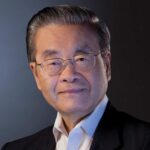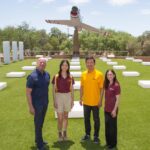
ASU engineers poised for progress in solar power quest

ASU engineering faculty are delving into every aspect of the quest to capture the power of the sun to provide a viable alternative source of electrical energy. Photo: Jessica Slater/ASU
Posted: May 06, 2011
Fulfilling the promise of solar energy as a robust large-scale alternative power source requires overcoming a variety of challenges.
Beyond the technological aspects, there are economic, regulatory, manufacturing, public policy and public utility issues to deal with.
In its research and education endeavors, Arizona State University’s Ira A. Fulton Schools of Engineering are delving into each facet of the quest to bring solar power to the forefront of the nation’s energy arsenal.
On the technical side, ASU’s engineers are working on advances in solar power generation at every level from the atomic scale to the industrial scale – from the use of nanoparticles to the design and operation of large power plants.
They’re also educating ASU students to become the future entrepreneurs and business leaders prepared to successfully commercialize new energy technologies, and the policy experts who can pave the way for effective implementation of alternative energy systems.
They’re partnering with industry and business interests to develop the solar energy workforce and laying groundwork for the infrastructure necessary to deliver solar power to the public.
Fundamental photovoltaics
Efficiency is the big technical challenge in solar research. It’s all about developing technologies to get the most energy out of sunlight.
The other big overall challenge is economics – getting the costs of producing and distributing power generated from sunlight down to a feasible level of affordability for widespread use.
Photovoltaic technologies are currently capable of converting roughly 20 percent to 40 percent of the energy in sunlight into electrical energy. Some experts think it’s possible to eventually increase that to close to 80 percent.
Pursuit of that goal includes rigorous study of fundamental physics. Electrical engineering professor Marco Saraniti works on predicting the performance of various kinds of photovoltaic cells based on understanding the physical properties and behaviors of the materials used to make the cells.
“If you follow what physics can reveal,” he says, “you get the recipes for how to put these materials together to achieve the most efficient operation” of solar power devices.
Materials science and engineering professor Mark van Schilfgaarde is looking at it from the most microscopic viewpoint. He’s studying “the fundamental physics and quantum mechanics that determine the properties of materials.”
His aim is to understand at the molecular level precisely how sunlight is converted in electrical energy. The answer can provide a basic theory of solar power generation, van Schilfgaarde says.
Such core knowledge “can help industry tremendously because it can make solar power experimentation less hit and miss. It tells you what kinds of things will work, how materials will perform and how to fix problems” with solar cells and solar energy systems, he says.
Mixing and matching materials
Saraniti’s and Van Schilfgaarde’s work is helpful to colleagues experimenting with various combinations of materials for constructing more efficient photovoltaic cells. Cells made with silicon, gallium, arsenide, zinc, germanium and magnesium are being tested, along with cells containing aluminum, indium, phosphorous and iron sulfite, cadmium and tellurium.
Materials engineering professor Nathan Newman is teaming with van Schilfgaarde and ASU chemistry professor Peter Buseck to seek ways to produce efficient photovoltaic devices using materials that are abundant in nature. This would enable the devices to be made inexpensively – a critical advance that’s needed to make it economically feasible to ramp up manufacturing of solar power technology for widespread public use.
Electrical engineering professors Yong-Hang Zhang and Cun-Zheng Ning are seeking to discover combinations of materials that will enable cells to better absorb more of the solar light spectrum, so that more energy from sunlight is provided for conversion into electrical power.
Ning is building solar cells arranged in parallel in a lateral direction using semiconductor nanowires. Zhang is stacking different materials one on top of another. They both are looking for ways to achieve power conversion efficiency beyond the current limit of about 40 percent.
Electrical engineering professor Dieter Schroder has led research to improve efficiency in solar energy conversion by finding ways to eliminate defects and impurities in materials used for solar cells.
Enhancing performance
Other researchers are experimenting with methods other than the use of photovoltaics to capture and convert solar energy. Mechanical engineering professors Patrick Phelan and Ron Adrian, and adjunct faculty member Ravi Prasher, are testing ideas for a solar thermal collector. It would generate power by concentrating sunlight into a liquid containing silver and graphite nanoparticles that can absorb solar energy more efficiently.
In this process the liquid would be heated sufficiently “to create a direct steam-generation solar system,” Phelan explains. With the use of large steam turbines, the technology could be the basis for a new kind of solar power plant.
Phelan is also working with utility companies and entrepreneurs on developing an air-conditioning system utilizing an engine that runs on a combination of heat generated by solar power and natural gas.
In addition to the task of improving the efficiency of systems for concentrating, collecting and converting solar energy, another major hurdle for renewable energy sources is finding ways to store adequate amounts of power for later use.
Progress on the energy-storage front could be aided by materials science and engineering professor Karl Sieradzki and associate professor Cody Friesen, who are collaborating with ASU chemistry professor Dan Buttry on new battery technologies that promise significant advances for electric vehicles.
Electrical engineering professors Andreas Spanias and George Maracas, and associate professor Cihan Tepedelenlioglu, are trying to provide industry and researchers with accurate measurement of the effectiveness and health of photovoltaic systems.
They’re using advanced sensor and signal-processing technology to devise systems to analyze how solar technology performs under a variety of situations, especially changing atmospheric and weather conditions.
Range of expertise
All of this material, electrical and mechanical engineering research is aiding pursuits in ASU’s Solar Power Lab to develop prototypes for the next generations of high-efficiency photovoltaic technologies.
Electrical engineering professors Stephen Goodnick and Christiana Honsberg, with associate research professor Stuart Bowden, are leading the Solar Power Lab’s efforts to design and model photovoltaic systems that can be manufactured using simpler processes and less material – producing sufficient power at a low cost per kilowatt hour of energy production.
“One of ASU’s strength is the range of expertise we have in energy-related engineering, particularly in photovoltaics and areas that can contribute to solar technology advances,” Goodnick says. “We have a team of some of the best solar energy researchers in the country.”
That expertise has helped ASU earn support for its energy research from the U.S. Department of Energy, the Department of Defense, the National Science Foundation and Science Foundation Arizona, the Electric Power Research Institute and the Western Electricity Coordinating Council.
It has also attracted industry support and research partnerships with businesses such as Boeing’s Spectrolab, General Electric, Viasol, Suntech, Samsung, Ganotec, Concentrix and Emcore, as well as the Salt River Project, Arizona Public Service and Tucson Electric Power utility companies, among others.
Developing the ‘smart grid’
ASU is also a partner in a multi-university project supported by the National Science Foundation that is exploring ways of reliably and economically integrating alternative energy sources – such as wind and solar – into the nation’s existing regional power grids.
Researchers are helping design a “smart grid” to provide a network for managing and delivering power generated from renewable energy sources, says electrical engineering professor Gerald Heydt, who leads ASU’s team for the project.
Engineering professor Vijay Vittal and associate professor Raja Ayyanar are involved with Heydt in developing AzSMART, an analysis system being designed to evaluate the impacts of introducing significant solar power generation in Arizona.
Working with the University of Arizona, and industry and government partners, ASU researchers are examining the electric grid technologies that would be required to develop a solar-power infrastructure in the state.
The effort includes evaluating the economic, financial and environmental impacts of solar power generation and distribution on consumers, utilities and other users, assessing suitable locations for large solar-power plants – and the technical requirements of linking the plants to existing energy grids – and consideration of policies to address energy-system security.
Vittal, Ayyanar and Heydt are working with Arizona Public Service company, General Electric, the Department of Energy, ViaSol energy company and the National Renewable Energy Laboratory to study the impact of solar photovoltaics on power distribution systems, and developing new control and protection methods to ensure reliability and power quality of such systems.
Improving critical components
In a related effort, Ayyanar is working on advances in power electronic inverters, a key component of photovoltaic systems.
He explains: “The capability of the inverter is critical whether it is a small roof-top residential system or a multi-megawatt utility scale solar power plant. The reliability and performance in terms of energy generated and power quality are critically affected by the inverter performance. We are researching new power electronic topologies and control methods to enhance the performance of solar inverters, developing models and aiding the development of new quality standards for inverters.”
The strength of ASU’s work in this area is one of the major reasons that Power One, a large inverter manufacturer, has opened facilities in Arizona, Ayyanar says.
Electrical engineering professor George Karady is helping lead research on microgrids, which involve re-engineering infrastructure so that it can effectively distribute power from renewable energy sources to cities, towns and neighborhoods.
He’s exploring not only the technical solutions to developing efficient microgrid systems, but ways to make them economically feasible and ensure their reliability and security.
Steven Trimble, an engineering professor of practice, has decades of industry experience in energy system design and technical management of the development of large-scale solar systems. His current research involves development of a combined solar energy generation and energy storage system that could help make smart grids and microgrids more economical to operate.
Preparing future solar leaders
Nearly all knowledge gleaned from discoveries in ASU’s solar power engineering research finds its way to students as new information is incorporated into course subjects, and numerous students are getting valuable hands-on experience by assisting research teams led by engineering faculty members.
In the spring 2011 semester a small group of students was the first to begin studies in the Ira A. Fulton Schools of Engineering’s new master’s degree program focusing on solar energy.
The Professional Science Masters in Solar Energy Engineering and Commercialization encompasses studies in the technological, economic, business and public policy aspects of the solar power field.
It offers much more than classroom instruction, says professor Phelan, who developed and directs the program. Students will be working on projects with companies in the energy and power industry, and visiting the nation’s capitol to get a firsthand look at governmental processes involved in development and deployment of new technologies and energy systems.
The degree program “will establish strong ties to industry, and stress entrepreneurship,” Phelan says. “When they graduate, students will be well connected in the field and prepared to make a contribution.”


































